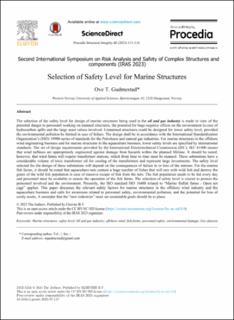| dc.contributor.author | Gudmestad, Ove Tobias | |
| dc.date.accessioned | 2024-04-09T12:38:58Z | |
| dc.date.available | 2024-04-09T12:38:58Z | |
| dc.date.created | 2023-09-28T00:37:05Z | |
| dc.date.issued | 2023 | |
| dc.identifier.citation | Procedia Structural Integrity. 2023, 48 113-118. | en_US |
| dc.identifier.issn | 2452-3216 | |
| dc.identifier.uri | https://hdl.handle.net/11250/3125545 | |
| dc.description.abstract | The selection of the safety level for design of marine structures being used in the oil and gas industry is made in view of the potential danger to personnel working on manned structures, the potential for huge negative effects on the environment in case of hydrocarbon spills and the large asset values involved. Unmanned structures could be designed for lower safety level, provided the environmental pollution be limited in case of failure. The design shall be in accordance with the International Standardization Organization's (ISO) 19900-series of standards for the Petroleum and natural gas industries. For marine structures in the offshore wind engineering business and for marine structures in the aquaculture business, lower safety levels are specified by international standards. The set of design requirements provided by the International Electrotechnical Commission (IEC); IEC 61400 ensure that wind turbines are appropriately engineered against damage from hazards within the planned lifetime. It should be noted, however, that wind farms will require transformer stations, which from time to time must be manned. These substations have a considerable volume of toxic transformer oil for cooling of the transformers and represent large investments. The safety level selected for the design of these substations will depend on the consequences of failure to or loss of the stations. For the marine fish farms, it should be noted that aquaculture nets contain a huge number of fishes that will mix with wild fish and destroy the genes of the wild fish population in case of massive escape of fish from the nets. The fish population needs to be fed every day and personnel must be available to ensure the operation of the fish farms. The selection of safety level is crucial to protect the personnel involved and the environment. Presently, the ISO standard ISO 16488 related to “Marine finfish farms - Open net cage” applies. This paper discusses the relevant safety factors for marine structures in the offshore wind industry and the aquaculture business and calls for awareness related to personnel safety, environmental pollution, and the potential for loss of costly assets, A reminder that the “new industries” must set sustainable goals should be in place. | en_US |
| dc.language.iso | eng | en_US |
| dc.publisher | Elsevier | en_US |
| dc.rights | Attribution-NonCommercial-NoDerivatives 4.0 Internasjonal | * |
| dc.rights.uri | http://creativecommons.org/licenses/by-nc-nd/4.0/deed.no | * |
| dc.title | Selection of Safety Level for Marine Structures | en_US |
| dc.type | Peer reviewed | en_US |
| dc.type | Journal article | en_US |
| dc.description.version | publishedVersion | en_US |
| dc.rights.holder | © 2023 The Authors | en_US |
| dc.source.pagenumber | 113-118 | en_US |
| dc.source.volume | 48 | en_US |
| dc.source.journal | Procedia Structural Integrity | en_US |
| dc.identifier.doi | 10.1016/j.prostr.2023.07.117 | |
| dc.identifier.cristin | 2179653 | |
| cristin.ispublished | true | |
| cristin.fulltext | original | |
| cristin.qualitycode | 1 | |

